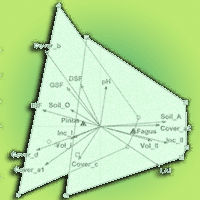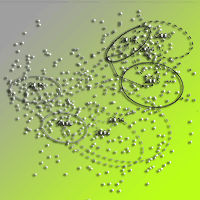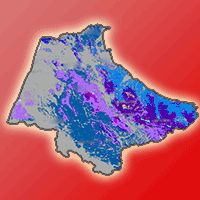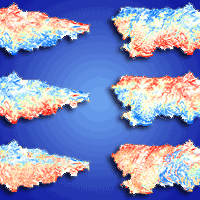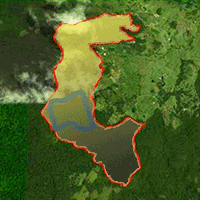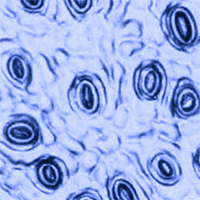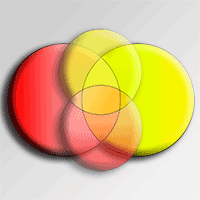
How environmental factors condition natural regeneration in the altitudinal gradient of a montane rainforest
Victor Braga Rodrigues Duarte (1) , Vítor Abreu de Souza (2), Henrique Machado Dias (1), Sustanis Horn Kunz (1), Eduardo Van Den Berg (3)
iForest - Biogeosciences and Forestry, Volume 17, Issue 3, Pages 132-139 (2024)
doi: https://doi.org/10.3832/ifor4319-017
Published: May 04, 2024 - Copyright © 2024 SISEF
Research Articles
Abstract
The response of plant species to the variation in abiotic factors affects the regeneration capacity and, consequently, the structure of the forest community. This study aims to describe the structure of the regenerating stratum in a Brazilian montane rainforest and investigate its relationship with environmental and spatial variables along an altitudinal gradient. Data on the height and diameter at soil height of regenerating individuals and environmental variables were collected from 28 sample units, distributed in seven altitudinal sites. To understand the spatial influence on species distribution, spatial variables (MEMs - Moran’s Eigenvector Maps) were created based on geographic coordinates. Phytosociological parameters were calculated by species. Floristic similarity between the altitudinal quota was determined by the Bray-Curtis index (UPGMA), and the species that characterize each group were determined by the Indicator Species Analysis. Redundancy Analysis (RDA) was performed, and generalized linear models were adjusted to verify the influence of environmental and spatial factors on regenerating vegetation. The species Palicourea sessilis had the highest Importance Value in the regenerating community. Two floristic groups were formed: the highest sites (1420 to 1550 m a.s.l.) were floristically more similar to each other (Group 1) than to the sites in the 1112 to 1391 m elevation range (Group 2). Overall, 11 species were indicators of Group 1 and only one of Group 2. Finally, a pattern of species substitution was verified as a function of abiotic factors. The first two axes of the RDA explained 51.02% of the variation in the floristic composition of the regenerating community. Natural regeneration demonstrated environmental preferences, being influenced by luminosity, abundance in adult components, calcium and sodium contents, plant litter accumulation, altitude, and the spatial structure of the environment. Altitude did not seem to influence the pattern of abundance or richness of regenerating species.
Keywords
Environmental Variation, Species Distribution, Vegetation-Environment Relationship, Elevation, Understory
Authors’ Info
Authors’ address
Henrique Machado Dias 0000-0003-2217-7846
Sustanis Horn Kunz 0000-0001-6937-7787
Department of Forest and Wood Sciences, Federal University of Espírito Santo, 29550-000, Jeronimo Monteiro, Espírito Santo (Brazil)
Department of Forest Sciences, Federal University of Lavras, 37200-900, Lavras, Minas Gerais (Brazil)
Department of Ecology and Conservation, Federal University of Lavras, 37200-900, Lavras, Minas Gerais (Brazil)
Corresponding author
Paper Info
Citation
Braga Rodrigues Duarte V, Abreu de Souza V, Machado Dias H, Horn Kunz S, Van Den Berg E (2024). How environmental factors condition natural regeneration in the altitudinal gradient of a montane rainforest. iForest 17: 132-139. - doi: 10.3832/ifor4319-017
Academic Editor
Susanna Nocentini
Paper history
Received: Jan 31, 2023
Accepted: Feb 08, 2024
First online: May 04, 2024
Publication Date: Jun 30, 2024
Publication Time: 2.87 months
Copyright Information
© SISEF - The Italian Society of Silviculture and Forest Ecology 2024
Open Access
This article is distributed under the terms of the Creative Commons Attribution-Non Commercial 4.0 International (https://creativecommons.org/licenses/by-nc/4.0/), which permits unrestricted use, distribution, and reproduction in any medium, provided you give appropriate credit to the original author(s) and the source, provide a link to the Creative Commons license, and indicate if changes were made.
Web Metrics
Breakdown by View Type
Article Usage
Total Article Views: 6321
(from publication date up to now)
Breakdown by View Type
HTML Page Views: 1977
Abstract Page Views: 1779
PDF Downloads: 2257
Citation/Reference Downloads: 3
XML Downloads: 305
Web Metrics
Days since publication: 613
Overall contacts: 6321
Avg. contacts per week: 72.18
Citation Metrics
Article Citations
Article citations are based on data periodically collected from the Clarivate Web of Science web site
(last update: Mar 2025)
(No citations were found up to date. Please come back later)
Publication Metrics
by Dimensions ©
Articles citing this article
List of the papers citing this article based on CrossRef Cited-by.
References
Regeneração natural e banco de sementes do solo em um gradiente altitudinal de Floresta Ombrófila Densa [Natural regeneration and soil seed bank along an altitudinal gradient of Ombrophilous Rainforest]. M.Sc. thesis, Federal University of Espírito Santo, Jerônimo Monteiro, ES, Brazil, pp. 125. [in Portuguese]
Gscholar
Similaridade entre adultos e regenerantes do componente arbóreo em floresta com Araucária [Similarity between adults and regenerants of the tree component in Araucaria forest]. Floresta e Ambiente 24: e00083214. [in Portuguese]
CrossRef | Gscholar
Estrutura, composição florística e relação vegetação-ambiente em Floresta Ombrófila Densa no Parque Nacional do Caparaó, Espírito Santo [Structure, floristic composition and vegetation environment relationship in Tropical Rainforest, Caparaó National Park, Espírito Santo]. M. Sc. thesis, Federal University of Espírito Santo, Jerônimo Monteiro, ES, Brazil, pp. 129. [in Portuguese]
Gscholar
Soil resources and topography shape local tree community structure in tropical forests. Proceedings of the Royal Society B 280: 20122532.
CrossRef | Gscholar
Numerical ecology with R. Springer, New York, USA, pp. 117-128.
Gscholar
Influência de fatores edáficos sobre variações florísticas na Floresta Estacional Semidecídua no entorno da Lagoa Carioca, Parque Estadual do Rio Doce, MG, Brasil [Influence of soil factors on floristic variation in a semideciduous seasonal forest on the shores of Carioca Lake, Rio Doce State Park, Minas Gerais State, Brazil]. Acta Botanica Brasilica 22: 75-84. [in Portuguese]
CrossRef | Gscholar
Aplicação da diversidade alfa e beta para definição de áreas prioritárias para conservação: uma análise das florestas deciduais sobre afloramentos calcários no vale do Paranã, Goiás [Use of alpha and beta diversity as a base to select priority areas for conservation: an analysis of the dry forests on limestone outcrops in Paranã valley, Goiás state, Brazil]. Bioscience Journal 27: 830-838. [in Portuguese]
Gscholar
Serapilheira e estoque de carbono ao longo de um gradiente altitudinal na Floresta Ombrófila Densa, no Parque Nacional do Caparaó, ES [Litter and carbon stock along an altitudinal gradient in the Tropical Rain Forest in Caparaó National Park, ES]. M.Sc. thesis, Federal University of Espírito Santo, Jerônimo Monteiro, ES, Brazil, pp. 99. [in Portuguese]
Gscholar
Ciclagem de nutrientes em diferentes condições edafoclimáticas em trecho de floresta ombrófila densa [Nutrient cycling in different edaphoclimatic conditions in Tropical Montane Rain Forest]. PhD thesis, Federal University of Espírito Santo, Jerônimo Monteiro, ES, Brazil, pp. 167. [in Portuguese]
Gscholar
Disturbances, elevation, topography and spatial proximity drive vegetation patterns along an altitudinal gradient of a top biodiversity hotspot. Biodiversity and Conservation 22: 2767-2783.
CrossRef | Gscholar
Estrato de regeneração natural de um trecho de Floresta Estacional Semidecidual, Viçosa, MG [Natural regeneration layer of a semideciduous forest fragment in Viçosa, Minas Gerais state, Brazil]. Revista Árvore 38: 31-40. [in Portuguese]
CrossRef | Gscholar
Levantamento florístico e caráter sucessional das espécies arbustivo-arbóreas de uma Floresta Mesófila Semidecídua no município de Guarulhos, SP [Floristic survey and successional character of the shrub and tree species of a semideciduous forest in the municipality of Guarulhos, SP]. Revista Brasileira de Biologia 55: 783-767. [in Portuguese]
Gscholar
Manual técnico da vegetação brasileira [Technical manual of Brazilian vegetation]. Instituto Brasileiro de Geografia e Estatística - IBGE, Rio de Janeiro, Brazil, pp. 275. [in Portuguese]
Gscholar
Regeneração natural de um fragmento de Floresta Ombrófla Densa na Bacia Hidrográfca do Rio Capibaribe, PE [Natural regeneration of a dense ombrophilous forest fragment in the Capibaribe River Basin, PE]. Revista Brasileira de Ciências Agrárias 8: 273-278. [in Portuguese]
CrossRef | Gscholar
Medindo a diversidade biológica [Measuring biological diversity]. EdUFPR, Curitiba, Brazil, pp. 262. [in Portuguese]
Gscholar
Plano de Manejo do Parque Nacional do Caparaó [Caparaó National Park management plan]. Ministério do Meio Ambiente, Agência Comunica, Publicidade e Marketing Ltda, Brasília, Brazil, pp. 517. [in Portuguese]
Gscholar
Fitossociologia da regeneração natural de uma Floresta Ombrófila Densa em Moreno, Pernambuco, Brasil [Phytosociology of natural regeneration of a Dense Rainforest in Moreno, Pernambuco, Brazil]. Revista Brasileira de Ciências Agrárias 8: 119-124. [in Portuguese]
CrossRef | Gscholar
Sobrevivência e crescimento de mudas de regeneração natural de Astronium gracile Engl. em clareiras causadas por exploração florestal na Amazônia brasileira [Survival and growth rate of seedlings from natural regeneration of Astronium gracile Engl. in gaps caused by reduced impact logging in the Brazilian Amazon]. Ciência Florestal 23: 411-416. [in Portuguese]
CrossRef | Gscholar
Fitossociologia da regeneração natural de um fragmento urbano de Floresta Estacional Semidecidual (Juiz de Fora, MG) [Phytosociology of natural regeneration in an urban fragment of semideciduous seasonal forest (Juiz de Fora, MG, Brazil)]. Revista Brasileira de Ciências Agrárias 9: 117-123. [in Portuguese]
CrossRef | Gscholar
Diversidade florística e estrutura fitossociológica de um gradiente topográfico em Floresta Estacional Semidecidual Submontana, MG [Diversity and phytosociological structure of a topographic gradient in seasonal semidecidual forest of Mata Mumbaça, MG]. Cerne 19: 489-499. [in Portuguese]
CrossRef | Gscholar


